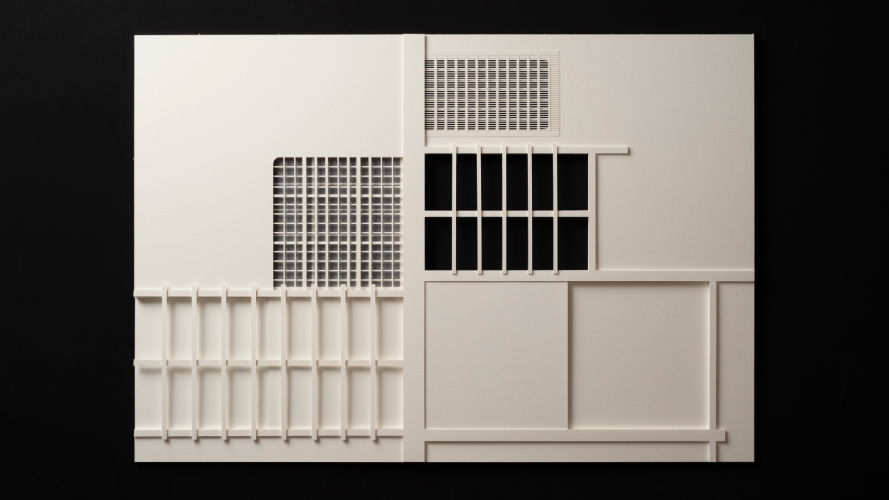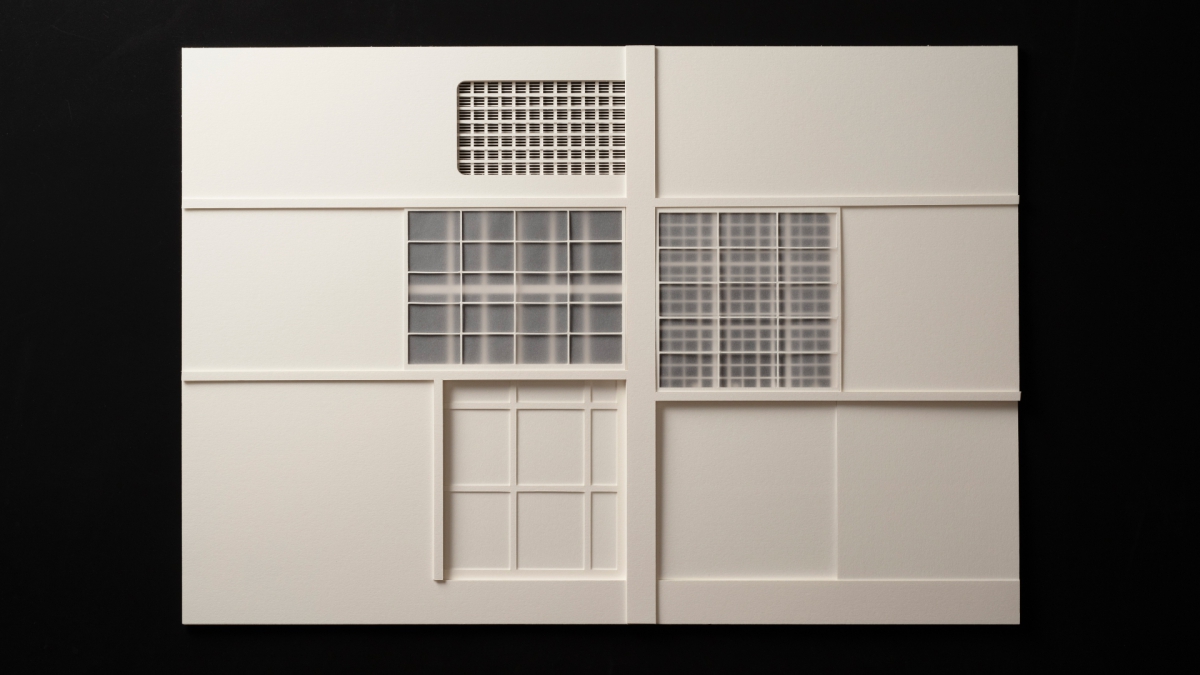
016
06-07 Shitajimado and Renjimado
Another instance where Enshu used his favorite combination of an upper shitajimado (exposed lath window) and lower renjimado (slatted window). This shitajimado has a woven blind (sudare) on its exterior side, and the renjimado has a single sliding paper screen on its interior side.
08 Nijiriguchi
A nijiriguchi (lit. “wriggle-in entrance”) is a small entrance made for tea ceremony guests. It is also known as a kuguri (lit. “duck-through”), and it is fitted with a single sliding door panel called a nijirido (lit. “wriggle-in door”) or sasado (lit. “narrow door”). These door panels are said to have originally been made by cutting wood board shutters (amado), and the simplicity of their designs speaks to their origins. They are constructed as what is called a nimaihan (lit. “two and a half boards”), and as the name suggests, they are composed of two wide plain-sawn boards and one narrow quarter-sawn board, which are arranged in the order of large-medium-small or large-large-small. They are typically held together from the inside by battens fixed to the middle and upper part of the boards and do not have a top rail.
09-10 Shitajimado and Renjimado
In this instance where Enshu used his favored combination of an upper shitajimado (exposed lath window) and a lower renjimado (slatted window), the shitajimado has a single sliding paper screen, and the renjimado has double sliding paper panels. The tea ceremony host can control the amount of light that enters the room and use it for effect by adjusting these sliding paper panels, which shut out sunlight like solid walls when closed and become bright, airy apertures when opened.
About the Yosuitei
Japanese teahouses (chashitsu) are unique buildings with small interiors and many types of windows. The Yosuitei is a thatched hut-style teahouse from the Kanei era (1624–1644) of the early Edo period. It was commissioned by Toshitsune Maeda, the second lord of the Kaga Domain, and built alongside a waiting shelter and a reception hall with a dais at the residence of Kakujo Goto, a sword engraver and Maeda clan liege based in Kyo (present-day Kyoto). Designed by Enshu Kobori, the multiwindowed teahouse is also referred to as the Jusansoseki (lit. “Thirteen-Window Tearoom”) based on the fact that it has thirteen windows, which is the most of any extant teahouse. This project aims to extract the subtle, rich behaviors of the Yosuitei’s thirteen windows by studying the sounds and movements that they make when opened and closed.
06-07 下地窓と連子窓
遠州が好んだ連子窓の上に下地窓を重ねる手法。下地窓の室外側には簾、連子窓の室内側は片引き障子で構成されている。
08 躙口
躙口(にじりぐち)とは、客のために設けられた、片引戸の小さな出入口のこと。躙口は、「潜り」(くぐり)とも言う。躙口の潜りの戸は、躙戸(にじりど)または細戸(ささど)とも呼ばれ、躙口の建具に雨戸を切断して用いたと言われ、その簡素さを表現している。上框がなく、二枚半といわれるように、三枚の平板を大中小または大大小の割で並べ、幅の広い二枚は板目、幅の狭い一枚は柾目で、内側の中程と上の方に横に桟(さん)を打ちつけてある。
09-10 下地窓と連子窓
遠州が好んだ連子窓の上に下地窓を重ねる手法で、下地窓は片引き障子、連子窓は両引きの襖で構成されている。畳際の小襖は、閉めると壁のように光を遮り、開くと明るく開放的になり、茶会の亭主の趣向により光量を調整することができ、光の演出が可能となる。
擁翠亭について
日本の茶室は狭い空間に多くの種類の窓を備えた特殊な建築物である。擁翠亭は、江戸時代前期の寛永年間(一六二四~一六四四)に、加賀藩二代藩主前田利常が、京の装剣金工師で前田家の家臣であった後藤覚乗の屋敷に、上段付きの書院や堂腰掛とともに建てた草庵茶室。設計は小堀遠州。十三の窓を持つ多窓茶室であったことから、別名を「十三窓席」と言い現存する茶室で最も窓の多い茶室として知られている。本プロジェクトでは、擁翠亭の窓の開閉する音と動きを観察し、十三窓の繊細で豊かな振る舞いを抽出することを目的としている。
Project No:
016
Year:
2021-22
Credit:
Research: Yoh Komiyama
Video: Tomohiro Okazaki
Sound Analysis: INVISI
Production: Window Research Institute
Special Assistance: Yosuitei Preservation Society
Translation: Gen Machida

